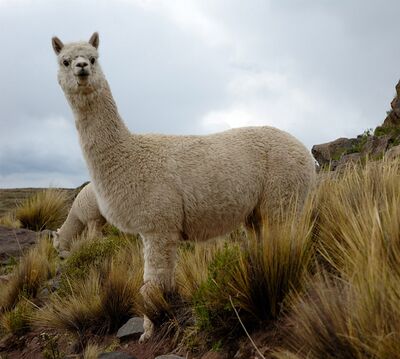- v50 information can now be added to pages in the main namespace. v0.47 information can still be found in the DF2014 namespace. See here for more details on the new versioning policy.
- Use this page to report any issues related to the migration.
Alpaca
| This article was migrated from DF2014:Alpaca and may be inaccurate for the current version of DF (v53.01). See this page for more information. |
|
a
| |
| Urist likes alpacas for their wool.
| |
|---|---|
| Biome | |
|
| |
| Attributes | |
| Tamed Attributes | |
| Pet value | 200 |
|
| |
|
Not hunting/war trainable | |
| Size | |
| Birth: | 7,000 cm3 |
| Mid: | 35,000 cm3 |
| Max: | 70,000 cm3
|
| Age | |
| Adult at: | 1 |
| Max age: | 10-20 |
| Butchering returns | |
|
Food items | |
| Meat | 12 |
| Fat | 12 |
| Brain | 1 |
| Heart | 1 |
| Lungs | 2 |
| Intestines | 1 |
| Liver | 1 |
| Kidneys | 2 |
| Tripe | 1 |
| Sweetbread | 1 |
| Spleen | 1 |
|
Raw materials | |
| Bones | 16 |
| Skull | 1 |
| Skin | Raw hide |
| Wool | 7 |
v53.01 · v0.47.05 This article is about the current version of DF.Note that some content may still need to be updated. |
- A large domestic animal with a long neck. It has been bred for its valuable hair.
Alpacas are common domestic livestock available to most any civilization. Alpacas can be sheared to yield wool, which can be used to make low-value cloth. In addition to the standard meat industry products, alpacas also supply wool when butchered.
Female alpacas can be milked, and that milk can then be cooked or made into cheese.
As grazers, alpacas require a moderately-sized pasture to survive; however they eat far less grass than cattle, and make an excellent base animal for combined meat, cheese, and cloth industries.
Alpaca wool is equivalent in value to the wool of all other shearable creatures.
Some dwarves like alpacas for their long necks, their jutting teeth, their wool, and their resemblance to a miniature llama.
In Real Life
In real life, alpacas are bred and kept for their highly valuable wool, which is prized for its softness and color. It is commonly referred to as "The fiber of the Gods" due to its silk-like feeling.
[CREATURE:ALPACA]
[DESCRIPTION:A large domestic animal with a long neck. It has been bred for its valuable hair.]
[NAME:alpaca:alpacas:alpaca]
[CASTE_NAME:alpaca:alpacas:alpaca]
[CHILD:1][GENERAL_CHILD_NAME:baby alpaca:baby alpacas]
[CREATURE_TILE:'a'][COLOR:7:0:1]
[CREATURE_CLASS:MAMMAL]
[PETVALUE:200]
[PREFSTRING:long necks]
[PREFSTRING:jutting teeth]
[PREFSTRING:wool]
[PREFSTRING:resemblance to a miniature llama]
[LARGE_ROAMING]
[COMMON_DOMESTIC]
[BENIGN][MEANDERER][PET]
[VISION_ARC:50:310]
[STANDARD_GRAZER]
[BODY:QUADRUPED_NECK:TAIL:2EYES:2EARS:NOSE:2LUNGS:HEART:GUTS:ORGANS:THROAT:NECK:SPINE:BRAIN:SKULL:MOUTH:TONGUE:GENERIC_TEETH:RIBCAGE]
[NATURAL]
[BODY_DETAIL_PLAN:STANDARD_MATERIALS]
[SELECT_MATERIAL:HAIR]
[STATE_NAME:ALL_SOLID:wool]
[STATE_ADJ:ALL_SOLID:wool]
[YARN]
[BODY_DETAIL_PLAN:STANDARD_TISSUES]
[SELECT_TISSUE:HAIR]
[TISSUE_NAME:wool:NP]
[BODY_DETAIL_PLAN:VERTEBRATE_TISSUE_LAYERS:SKIN:FAT:MUSCLE:BONE:CARTILAGE]
[BODY_DETAIL_PLAN:BODY_HAIR_TISSUE_LAYERS:HAIR]
[SELECT_TISSUE_LAYER:HEART:BY_CATEGORY:HEART]
[PLUS_TISSUE_LAYER:SKIN:BY_CATEGORY:THROAT]
[TL_MAJOR_ARTERIES]
[SELECT_TISSUE_LAYER:HAIR:BY_CATEGORY:ALL]
[TL_RELATIVE_THICKNESS:10]
[BODY_DETAIL_PLAN:STANDARD_HEAD_POSITIONS]
[BODY_DETAIL_PLAN:HUMANOID_RIBCAGE_POSITIONS]
[USE_MATERIAL_TEMPLATE:SINEW:SINEW_TEMPLATE]
[TENDONS:LOCAL_CREATURE_MAT:SINEW:200]
[LIGAMENTS:LOCAL_CREATURE_MAT:SINEW:200]
[HAS_NERVES]
[USE_MATERIAL_TEMPLATE:BLOOD:BLOOD_TEMPLATE]
[BLOOD:LOCAL_CREATURE_MAT:BLOOD:LIQUID]
[CREATURE_CLASS:GENERAL_POISON]
[GETS_WOUND_INFECTIONS]
[GETS_INFECTIONS_FROM_ROT]
[USE_MATERIAL_TEMPLATE:PUS:PUS_TEMPLATE]
[PUS:LOCAL_CREATURE_MAT:PUS:LIQUID]
[BODY_SIZE:0:0:7000]
[BODY_SIZE:1:0:35000]
[BODY_SIZE:2:0:70000]
[BODY_APPEARANCE_MODIFIER:LENGTH:90:95:98:100:102:105:110]
[BODY_APPEARANCE_MODIFIER:HEIGHT:90:95:98:100:102:105:110]
[BODY_APPEARANCE_MODIFIER:BROADNESS:90:95:98:100:102:105:110]
[MAXAGE:10:20]
[ATTACK:KICK:BODYPART:BY_CATEGORY:FOOT_FRONT]
[ATTACK_SKILL:STANCE_STRIKE]
[ATTACK_VERB:kick:kicks]
[ATTACK_CONTACT_PERC:100]
[ATTACK_PREPARE_AND_RECOVER:4:4]
[ATTACK_PRIORITY:MAIN]
[ATTACK_FLAG_WITH]
[ATTACK_FLAG_BAD_MULTIATTACK]
[ATTACK:KICK:BODYPART:BY_CATEGORY:FOOT_REAR]
[ATTACK_SKILL:STANCE_STRIKE]
[ATTACK_VERB:kick:kicks]
[ATTACK_CONTACT_PERC:100]
[ATTACK_PREPARE_AND_RECOVER:4:4]
[ATTACK_PRIORITY:MAIN]
[ATTACK_FLAG_WITH]
[ATTACK_FLAG_BAD_MULTIATTACK]
[ATTACK:BITE:CHILD_BODYPART_GROUP:BY_CATEGORY:HEAD:BY_CATEGORY:TOOTH]
[ATTACK_SKILL:BITE]
[ATTACK_VERB:bite:bites]
[ATTACK_CONTACT_PERC:100]
[ATTACK_PENETRATION_PERC:100]
[ATTACK_FLAG_EDGE]
[ATTACK_PREPARE_AND_RECOVER:3:3]
[ATTACK_PRIORITY:SECOND]
[ATTACK_FLAG_CANLATCH]
[DIURNAL]
[HOMEOTHERM:10068]
[APPLY_CREATURE_VARIATION:STANDARD_QUADRUPED_GAITS:900:711:521:293:1900:2900] 30 kph
[APPLY_CREATURE_VARIATION:STANDARD_SWIMMING_GAITS:9000:8900:8825:8775:9500:9900] 1 kph, NO DATA
[APPLY_CREATURE_VARIATION:STANDARD_CRAWLING_GAITS:9000:8900:8825:8775:9500:9900] 1 kph, NO DATA
[SWIMS_INNATE]
[MUNDANE]
[CASTE:FEMALE]
[FEMALE]
[MULTIPLE_LITTER_RARE]
[USE_MATERIAL_TEMPLATE:MILK:MILK_TEMPLATE]
[STATE_NAME:ALL_SOLID:frozen alpaca's milk]
[STATE_ADJ:ALL_SOLID:frozen alpaca's milk]
[STATE_NAME:LIQUID:alpaca's milk]
[STATE_ADJ:LIQUID:alpaca's milk]
[STATE_NAME:GAS:boiling alpaca's milk]
[STATE_ADJ:GAS:boiling alpaca's milk]
[PREFIX:NONE]
[MILKABLE:LOCAL_CREATURE_MAT:MILK:20000]
[USE_MATERIAL_TEMPLATE:CHEESE:CREATURE_CHEESE_TEMPLATE]
[STATE_NAME:SOLID:alpaca cheese]
[STATE_ADJ:SOLID:alpaca cheese]
[STATE_NAME:SOLID_POWDER:alpaca cheese powder]
[STATE_ADJ:SOLID_POWDER:alpaca cheese powder]
[STATE_NAME:LIQUID:melted alpaca cheese]
[STATE_ADJ:LIQUID:melted alpaca cheese]
[STATE_NAME:GAS:boiling alpaca cheese]
[STATE_ADJ:GAS:boiling alpaca cheese]
[PREFIX:NONE]
[CASTE:MALE]
[MALE]
[SET_BP_GROUP:BY_TYPE:LOWERBODY][BP_ADD_TYPE:GELDABLE]
[SELECT_CASTE:ALL]
[SET_TL_GROUP:BY_CATEGORY:ALL:HAIR]
[TL_COLOR_MODIFIER:BLACK:1:BROWN:1:WHITE:1:GRAY:1:LIGHT_BROWN:1:DARK_BROWN:1:TAN:1:AUBURN:1:CHESTNUT:1:SLATE_GRAY:1:CREAM:1:CINNAMON:1:BUFF:1:BEIGE:1:CHOCOLATE:1:CHARCOAL:1:ASH_GRAY:1:RUSSET:1:IVORY:1:FLAX:1:PUMPKIN:1:GOLD:1:GOLDEN_YELLOW:1:GOLDENROD:1:COPPER:1:SAFFRON:1:AMBER:1:MAHOGANY:1:OCHRE:1:PALE_BROWN:1:RAW_UMBER:1:BURNT_SIENNA:1:BURNT_UMBER:1:SEPIA:1:DARK_TAN:1:PALE_CHESTNUT:1:DARK_CHESTNUT:1:TAUPE_PALE:1:TAUPE_DARK:1:TAUPE_SANDY:1:TAUPE_GRAY:1:TAUPE_MEDIUM:1:ECRU:1]
[TLCM_NOUN:wool:SINGULAR]
[TISSUE_LAYER_APPEARANCE_MODIFIER:LENGTH:0:0:0:0:0:0:0]
[APP_MOD_NOUN:wool:SINGULAR]
[APP_MOD_RATE:1:DAILY:0:300:0:0:NO_END]
[APP_MOD_DESC_RANGE:10:50:100:150:200:300]
[SHEARABLE_TISSUE_LAYER:LENGTH:300]
[SET_TL_GROUP:BY_CATEGORY:ALL:SKIN]
[TL_COLOR_MODIFIER:BROWN:1:BURNT_UMBER:1:CINNAMON:1:COPPER:1:DARK_BROWN:1:DARK_PEACH:1:DARK_TAN:1:ECRU:1:PALE_BROWN:1:PALE_CHESTNUT:1:PALE_PINK:1:PEACH:1:PINK:1:RAW_UMBER:1:SEPIA:1:TAN:1:TAUPE_PALE:1:TAUPE_SANDY:1]
[TLCM_NOUN:skin:SINGULAR]
[SET_TL_GROUP:BY_CATEGORY:EYE:EYE]
[TL_COLOR_MODIFIER:BLACK:1]
[TLCM_NOUN:eyes:PLURAL] |
